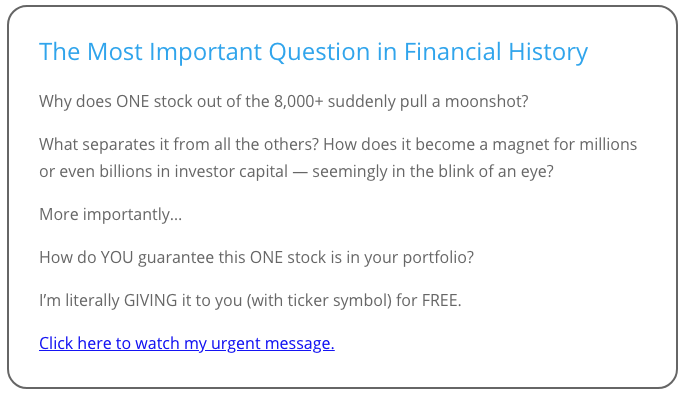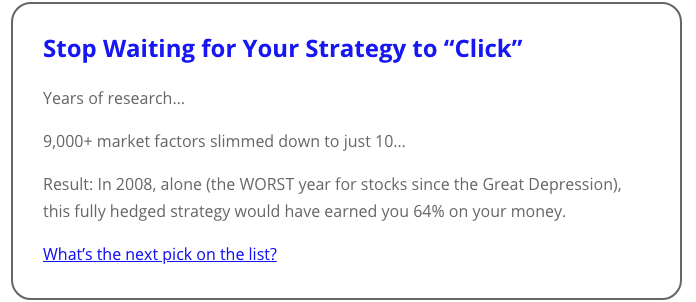Looking For Simple Swing Trading Stocks Strategies
There are hundreds if not thousands of swing trading stocks strategies that are available to traders today. Unfortunately, the majority of these strategies or techniques don’t provide the results traders are looking for.
Moreover, one of the biggest reasons traders don’t follow trading rules is because the strategy seems overly complicated or too advanced for beginners.
If you find you’re struggling following your trading rules… try a different approach! Base your Swing Trading Strategies on the K.I.S.S. principle …Keep It Simple and Straightforward!
From speaking with hundreds of traders this past year alone, most traders want simple easy to locate patterns or swing trading stocks strategies that don’t require hours of analysis.
No one wants to spend their entire weekend looking for buy and sell triggers for the following week.
Note: Many Swing Trading Stocks Strategies require advanced computer analysis, this method requires access to 52 week high low table that’s available in any newspaper and online at most stock trading sites.
Introducing the 52 High/Low Strategy
As you know, one very popular indicator of stocks moving up and down is the 52 week High/Low number. This represents all the stocks that are trading at the one year high price or one year low price. Investors and trades find these numbers very important for variety of reasons.
For instance, stocks that are making 52 week or 1 year price highs are known to be good investments because there’s little overhead resistance to deal with.
Stocks that are making yearly high prices have very few sellers in the way of the stock price going higher.
This is in addition to the fact that the stock must be doing something right on a fundamental level if it’s trading at a yearly high price.
Conversely, when stocks are near 52 week or 1 year low prices, the stock is deemed a dog by the industry and is typically added to multiple sell lists.
The company, industry, or sector that the stock is in may be performing below investors expectations as well. Either way, it’s considered a bearish sign, when stocks are trading at 52 week low.

Rationale behind the 52 High/Low Strategy
Because the 52 week high and 52 week low prices are on top of every publications swing trading stocks strategies list, there is no shortage of information for traders who want to find stocks trading near the 1 year low or 1 year high price.
This is one of the biggest reasons why many trades stay away from the 52 week list. There’s just too many traders already trading these stocks and as a result, buying stocks or selling stocks near the 52 price high/low tends to cause too many false breakouts and as a result too many losers.
Last time I checked, buying breakouts above 52 week price high was about 33 percent profitable. This means, 67 percent of all stocks making 52 week highs and lows tend to retrace from the high/low price.
What I wanted to find was a way to enter the 52 week high or low price without getting stopped out prematurely as occurs to 2/3 of all traders who trade 52 week breakouts.
After doing some research, I found out that the great majority of stocks that retrace away from the 52 week price high or low, but come back to break the 52 week price high or low tend to continue moving in the same direction about 65 percent of the time.
What does this mean to you ? simply if you wait for the market to bounce away from the 52 week price high or low and give it another chance to break out, the odds of your trade continuing in that direction is very high.
Not All Swing Trading Stocks Strategies Are Complicated
I created this strategy to help you trade 52 week price highs and 52 week price lows without the high chance of getting stopped out prematurely.
The 52 week high/Low Strategy is one of the simplest and easiest swing trading stocks strategies to learn and more importantly to follow. Here are the rules.
Here are the rules to go long:
- Monitor stocks making 52 week or 1 year price highs, the price can be an all time price high as well. Wait for the stock to come down and retrace some of it’s price.
You have to monitor the stock for the next 2 trading weeks or 10 trading days. If the market comes back up and breaks the 52 week or all time price high the 2nd time, go long .50 cents above the initial 52 week or all time high price.
- Once you enter the stock, you need to place a protective stop loss order. Take the price range of the entry day and double it. Subtract that number from your entry price and place your stop loss order at that level.
Since breakout trades experience more volatility than other strategies, you want to make sure to give your stocks some room to maneuver. If the high low range is a dollar, than double that and subtract it from your entry price.
- Your profit target is 4 times the trading range of your entry day. So if the range was 1 dollar, you would add 4 dollars to your entry price and that would be your profit target. I will show you some demonstrations so you get a feel for this.

Rules for short entry:
- Find stocks that are trading at the 52 week price low or all time price low. Notice the price and wait for the stock to pull back up for a few days. Wait no more than 10 trading days or 2 weeks for the market to come back to test the low price.
If it trades .50 cents below the low that was originally made enter the order to go short. But remember, you only have 2 weeks for the market to come back down to test the low price.
- Once you enter the trade, calculate the distance between the high and low price of your entry day and multiply it by two. Add that to your entry price and place your stop loss at that level.
- Your profit target is 4 times the trading range of your entry day. Multiply the range of your entry day by four or double your stop loss level and subtract that from your entry price. This is your profit target level.
The 52 week high/low is one of the simplest swing trading stocks strategies you can find. It also works remarkably well. The strategy works extremely well with Exchange Traded Funds or ETF’s for short.
Roger Scott
Senior Publisher
WealthPress



